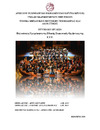Πολυκάναλη ηχογράφηση της Εθνικής Συμφωνικής Ορχήστρας της Ε.Ρ.Τ.
Multichannel recording of the National Symphony Orchestra (ERT).

Ημερομηνία
2020-09-24Συγγραφέας
Αναστασόπουλος, Ιωάννης
Γάτος, Άγγελος
Anastasopoulos, Ioannis
Gatos, Angelos
Μεταδεδομένα
Εμφάνιση πλήρους εγγραφήςΕπιτομή
Η εργασία αυτή έχει θέμα την πολυκάναλη ηχογράφηση μιας συμφωνικής ορχήστρας, καθώς και την επεξεργασία και μίξη της. Η παρούσα πτυχιακή χωρίζεται σε δύο μέρη. Το πρώτο μέρος αποτελείται από τα κεφάλαια ένα έως και πέντε, στα οποία αναγράφεται η θεωρία που υπάρχει πίσω από το πρακτικό κομμάτι της εργασίας. Το δεύτερο μέρος, απαρτίζεται από τα κεφάλαια έξι και επτά, στα οποία αναφέρεται αναλυτικά όλη η διαδικασία του πρακτικού μέρους. Στο τέλος, διατυπώνονται τα συμπεράσματα καθώς και οι δυσκολίες που αντιμετωπίσαμε. Η εγγραφή της συμφωνικής ορχήστρας πραγματοποιήθηκε στο στούντιο Δ της ΕΡΤ. Η βασική ιδέα ήταν η ταυτόχρονη ηχογράφηση του συνόλου της ορχήστρας σε πραγματικό χρόνο, υπό την μορφή μίας συναυλίας. Επιλέξαμε εξ’ αρχής την πολυκάναλη εγγραφή του μουσικού συνόλου, η οποία με την κατάλληλη επεξεργασία θα αποδώσει το επιθυμητό ηχητικό αποτέλεσμα. Κατά την διαδικασία της εγγραφής τοποθετήσαμε αρκετά μικρόφωνα, εκ των οποίων κάποια αποσκοπούσαν στην λήψη του συνόλου της ορχήστρας ή στην λήψη του φυσικού βάθους του χώρου, ενώ τα υπόλοιπα στην εγγραφή κάποιας ομάδας οργάνων της, ή σε κάποιο συγκεκριμένο όργανό της. Για την λήψη του συνόλου της ορχήστρας χρησιμοποιήθηκαν τεχνικές ηχογράφησης με δύο μικρόφωνα (στέρεο τεχνικές), όπως η Χ-Υ τεχνική, η Α-Β spaced και η ORTF, ενώ για την λήψη των ομάδων οργάνων ή ενός μόνο οργάνου, τοποθετήθηκε από ένα μικρόφωνο, το οποίο αποσκοπούσε στην αποκλειστική λήψη αυτών ή αυτού. Για την πολυκάναλη ηχογράφηση έγινε χρήση επαγγελματικού προγράμματος επεξεργασίας ήχου (Pro Tools), το οποίο λειτουργούσε μέσω ενός ηλεκτρονικού υπολογιστή, στην μνήμη του οποίου αποθηκεύτηκαν όλα τα audio wav αρχεία. Έπειτα από την διαδικασία της ηχογράφησης, πραγματοποιήθηκε η επεξεργασία και μίξη του προ-ηχογραφημένου υλικού στο στούντιο Ε της ΕΡΤ, με την χρήση του ίδιου λογισμικού software (Pro Tools). Αυτή η διαδικασία περιλαμβάνει την μίξη των εντάσεων, την στερεοφωνική εικόνα της ορχήστρας (Panning), την επέμβαση στις χροιές των οργάνων (Equalizer), την διαμόρφωση της δυναμικής περιοχής (Compressor) και την προσθήκη τεχνητού χώρου (Reverb). Τέλος, αφού ολοκληρώθηκε η διαδικασία της μίξης και επεξεργασίας του ήχου, ακολούθησε το στάδιο του mastering, το οποίο έγινε για την βελτίωση της στέρεο μίξης μας. This project's topic is multi-channel recording of a symphony orchestra, as well as its processing and mixing. This degree division is divided into two parts. The first part consists of chapters one to five, which outline the theory behind the practical part of the work. The second part consists of chapters six and seven, which detail the whole process of the practical part. In the end, the conclusions are drawn as well as the difficulties we have encountered. The symphony orchestra was recorded in ERT Hall D. The basic idea was simultaneous recording of the whole orchestra in real time in the form of a concert. We chose from the beginning the multi-channel recording of the musical ensemble, which, with proper editing, would prove the desired sound effect. During the recording process we installed several microphones, some of which were intended to capture the whole orchestra or to capture the physical depth of the space, while others were aimed at recording a particular group of organs, or a specific organ. We used it to get the whole orchestra two-microphone recording techniques (stereo techniques), such as X-Y technique, AB-spaced and ORTF, while for the reception of instrument groups or a single instrument, it was fitted with a microphone intended to be exclusively taken or that. Multi-channel recording was made using a professional audio editing software (Pro Tools), which operated on a computer in which all audio wav files were stored. Following the recording process, pre-recorded material was processed and mixed in ERT studio E using the same software (Pro Tools), operating on a computer in which all audio wav files were stored. Following the recording process, pre-recorded material was processed and mixed in ERT studio E using the same software (Pro Tools). This process involves mixing the volumes, the stereo image of the Panning, the interference with the Equalizer, the compressor configuration and the addition of a Reverb. Finally, after the process of mixing and processing the audio was completed, followed the stage of mastering, which was done to improve our stereo mix.
Συλλογές
Οι παρακάτω άδειες σχετίζονται με αυτό το τεκμήριο:
Αυτός ο ιστότοπος χρησιμοποιεί cookies για την λειτουργία του.
Συνέχεια
Περισσότερες πληροφορίες

